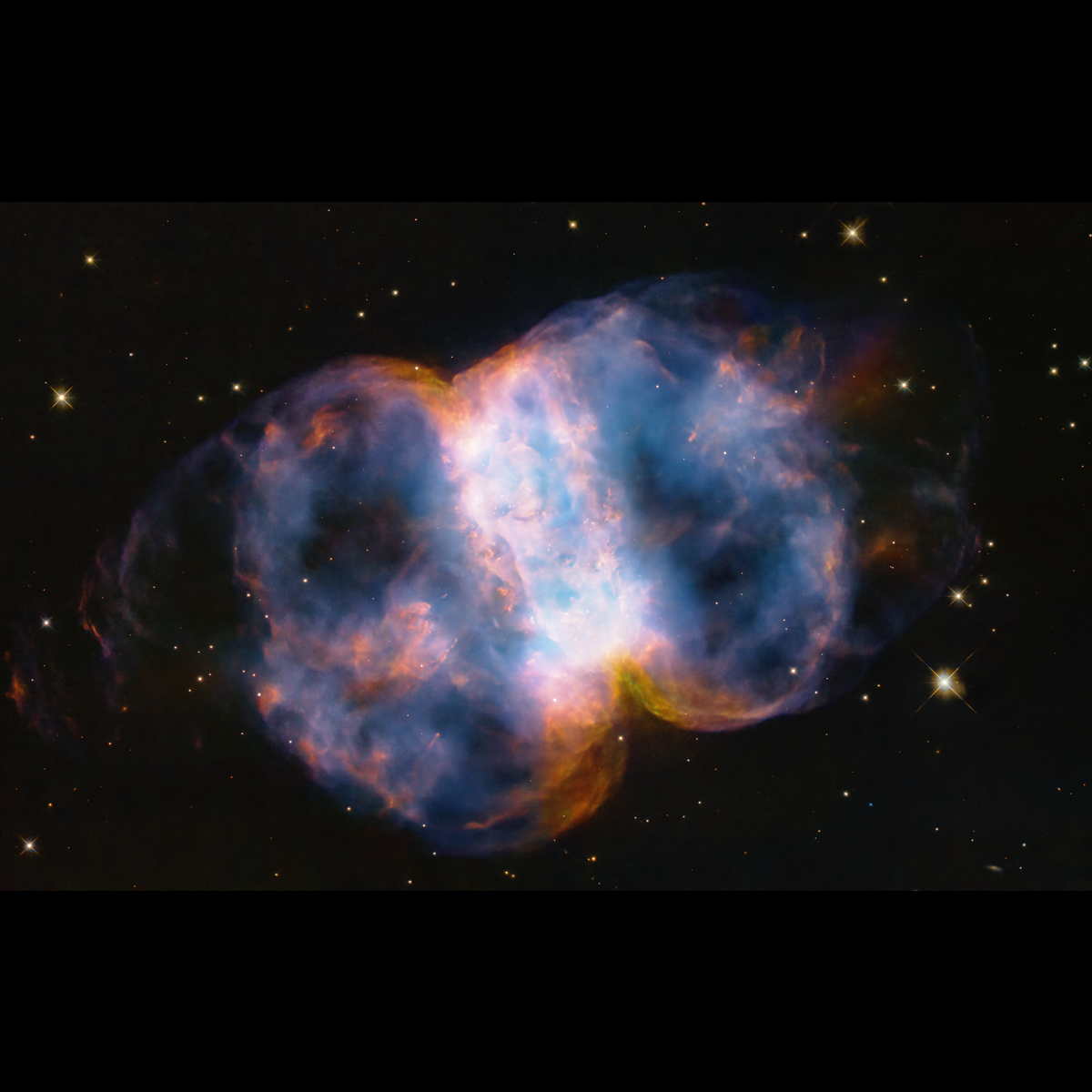In celebration of the 34th anniversary of the launch of NASA’s legendary Hubble Space Telescope on April 24, astronomers took a snapshot of the Little Dumbbell Nebula (also known as Messier 76, M76, or NGC 650/651) located 3,400 light-years away in the northern circumpolar constellation Perseus.
M76 is classified as a planetary nebula, an expanding shell of glowing gases that were ejected from a dying red giant star.
The hypothetical companion star isn’t seen in the Hubble image, and so it could have been later swallowed by the central star.
The space telescope is the most scientifically productive space astrophysics mission in NASA history.
NASA’s James Webb Space Telescope was designed to be meant to be complementary to Hubble, and not a substitute.
Future Hubble research also will take advantage of the opportunity for synergies with Webb, which observes the universe in infrared light.
The Hubble Space Telescope has been operating for over three decades and continues to make ground-breaking discoveries that shape our fundamental understanding of the universe.
The Space Telescope Science Institute in Baltimore, Maryland, which is operated by the Association of Universities for Research in Astronomy, conducts Hubble science operations for NASA.
Astronomers captured a picture of the Little Dumbbell Nebula, also known as Messier 76, M76, or NGC 650/651, which is 3,400 light-years away in the northern circumpolar constellation Perseus, to commemorate the 34th anniversary of NASA’s illustrious Hubble Space Telescope launch on April 24. Amateur astronomers’ favorite object to observe is the photogenic nebula.
An expanding shell of luminous gases expelled from a dying red giant star is known as a planetary nebula, and M76 is one of them. Ultimately, the star collapses into a hot, extremely dense white dwarf. Despite having nothing to do with planets, planetary nebulas got their name from astronomers who believed they resembled planets in the 1700s while using low-power telescopes.
M76 is made up of two lobes on either side of the ring aperture and a ring that is visible as the central bar structure when viewed edge-on. The ring of gas and dust was expelled by the star before it burned out. The star’s former binary companion star’s influence is likely what shaped the ring. Around the companion’s orbital plane, this sloughed-off material produced a thick disk of gas and dust. The potential companion star may have eventually been absorbed by the central star because it is not visible in the Hubble image. The disk would serve as corroborating proof of that star-eating phenomenon.
A white dwarf is being formed by the collapse of the main star. With a temperature of a whopping 250,000 degrees Fahrenheit, which is 24 times the surface temperature of our Sun, it is among the hottest known stellar remnants. The white dwarf is visible as a pinpoint at the nebula’s center. It is not a part of the nebula if a star can be seen projected beneath it.
Two lobes of hot gas, pinched off by the disk, are escaping from the top and bottom of the “belt,” along the rotation axis of the star, which is perpendicular to the disk. They are traveling through space at a speed of two million miles per hour, driven by the dying star’s hurricane-like outflow of material. This “stellar wind,” which is rushing at a speed of nearly seven minutes, is eroding cooler, slower-moving gas that was expelled from the star when it was still a red giant. The gases are glowing due to the intense ultraviolet radiation from the superhot star. Blue comes from oxygen, and red comes from nitrogen.
Cosmological timekeeping considers the entire nebula to be a flash in the pan, since our solar system is only 4.6 billion years old. In roughly 15,000 years, it will disappear.
A STAR TREKKING HIBBLE.
11.6 million observations of more than 53,000 astronomical objects have been made by Hubble since its launch in 1990. Astronomers from all over the world can use the 184 terabytes of processed data that are science-ready at the Mikulski Archive for Space Telescopes at the Space Telescope Science Institute in Baltimore, Maryland, for study and analysis. 44,000 scientific papers based on Hubble observations have been published since 1990. The space telescope represents the highest level of scientific productivity among NASA’s space astrophysics missions to date. The current oversubscription ratio for Hubble is six to one due to the high demand for its use.
Supermassive black holes, exoplanet atmospheres, gravitational lensing by dark matter, the existence of dark energy, and the prevalence of planet formation among stars are just a few of the findings made by Hubble that were not predicted prior to launch.
In addition to carrying out more research in those fields, Hubble will make use of its exceptional ability to see ultraviolet light to study subjects like solar system phenomena, supernovae explosions, the makeup of exoplanet atmospheres, and dynamic galaxy emission. Furthermore, the extensive baseline of Hubble observations of solar system objects, stellar variable phenomena, and other fascinating astrophysics of the cosmos continues to be useful for Hubble investigations.
The James Webb Space Telescope by NASA was intended to be an addition to Hubble, not a replacement. Hubble’s future research will also benefit from the chance to collaborate with Webb, which uses infrared light to observe the universe. As a result of the two space telescopes’ combined wavelength coverage, novel discoveries in the fields of protostellar disks, exoplanet composition, peculiar supernovae, galaxy cores, and the chemistry of the distant universe are being made.
After more than three decades of operation, the Hubble Space Telescope is still producing revolutionary findings that influence our basic conception of the cosmos. NASA and ESA (European Space Agency) collaborated internationally on the Hubble project. The telescope and mission operations are overseen by NASA’s Goddard Space Flight Center located in Greenbelt, Maryland. Additionally supporting Goddard mission operations is Denver, Colorado-based Lockheed Martin Space. NASA’s Hubble science operations are carried out by the Association of Universities for Research in Astronomy-run Space Telescope Science Institute in Baltimore, Maryland.




